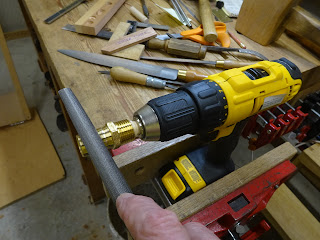The Stanley #5 that I found recently at a garage sale came with a poor excuse for a tote screw to hold the toe of the tote. It was all wrong: wrong head, wrong thread, just plain wrong.
 |
| The tote screw as found |
 |
| Here it is next to a correct screw from another plane. You can see the difference in threads and head. |
Unfortunately for us plane enthusiasts, Stanley used a 12-20 thread that did not gain wide use elsewhere and therefore is not made by anyone these days. At a recent tool show, one of the guys said he had spare tote screws and would bring one to the next tool show. But when I was looking into this, I read somebody suggesting the use of a 1/4-20 screw, modified to fit and I had to try it. It has the right number of threads per inch, just a larger diameter.
The 12-20 screw has a major diameter of about 0.211". I started with a 1/4-20 machine bolt that has a major diameter of about 0.248".
 |
| A 12-20 tote screw above, 1/4-20 machine bolt below. It was very helpful to have the extra length on the 1/4-20 to chuck it up in a drill without damaging the 1/2" of threads that I needed. |
 |
| Here, I'm filing 1/2" length of threads to about 0.211" diameter. |
 |
| I followed that using the edge of a small half round file to deepen the valleys between threads whose peaks I had filed down. I started with a triangular file, but that was cutting way too wide. |
 |
| Then I filed the head round and then to a rough domed shape and put it back in the drill to file and sand it smooth |
I hacksawed and filed a slot in the head, then cut off the unneeded length of threaded portion. I'd still like to make this look darker like the correct screw shown in the first picture, but for now, it works perfectly. If anybody knows a DIY method (using stuff I have - no harsh chemicals) of turning this screw dark, I'd love to know it.
 |
| The screw finished |
I'm not much of a metalworker, but damn, that is satisfying!




















